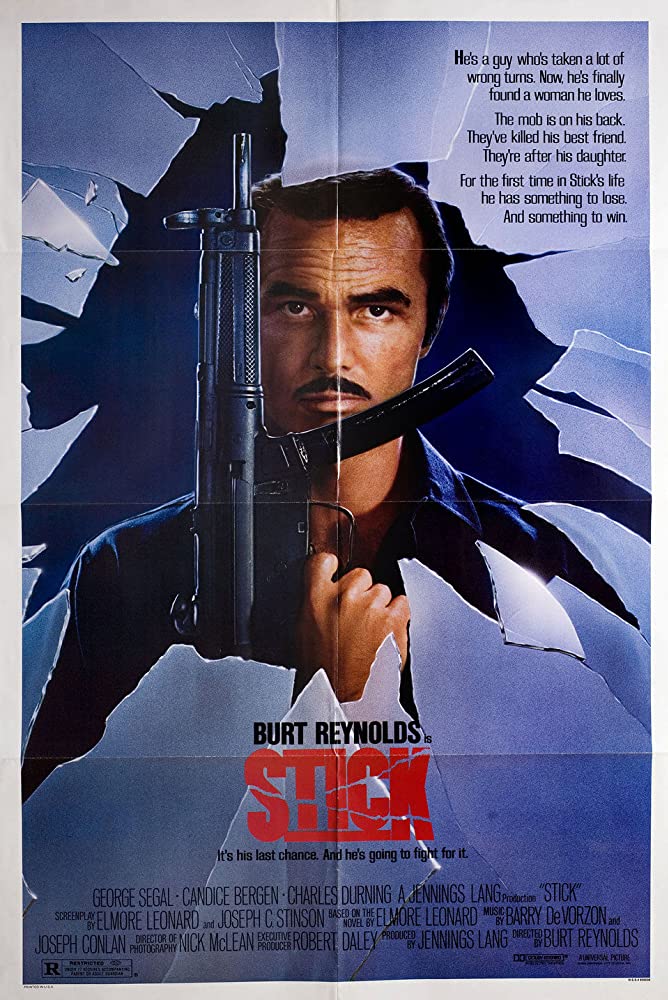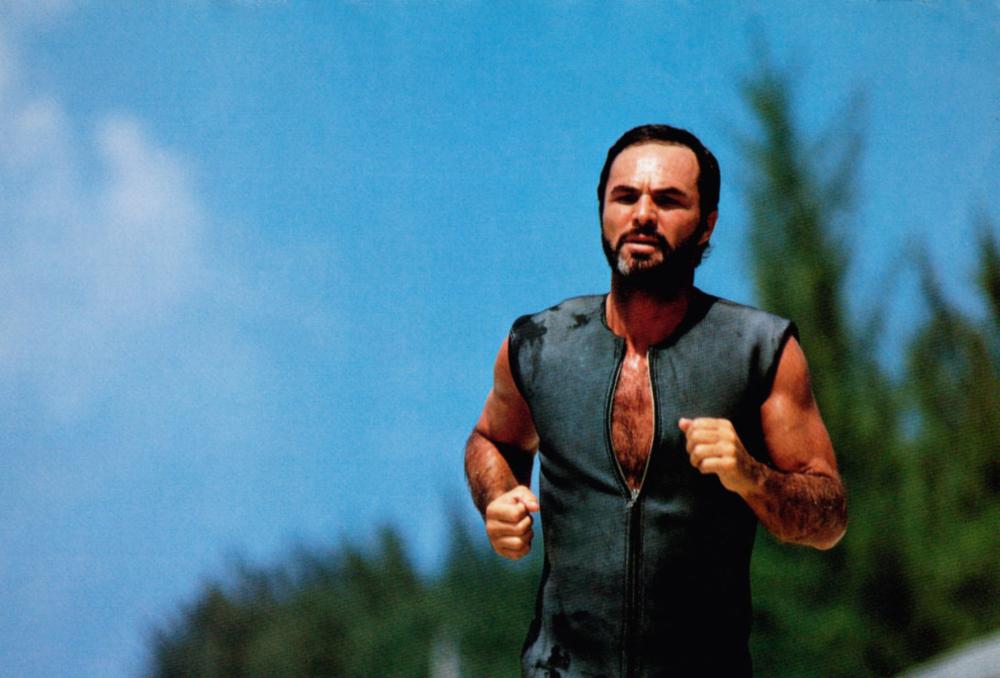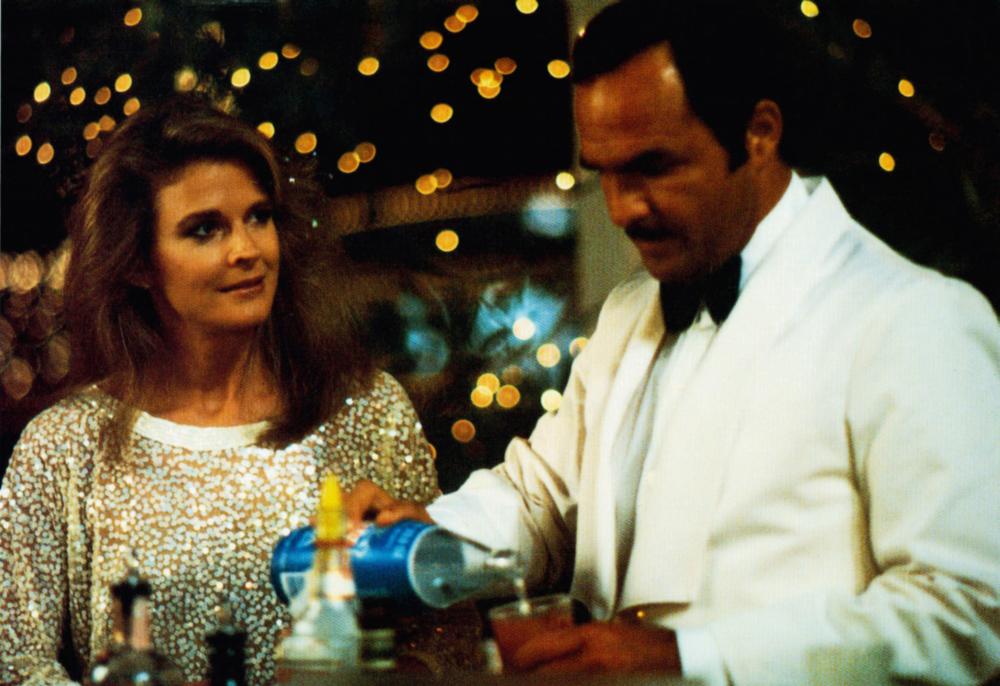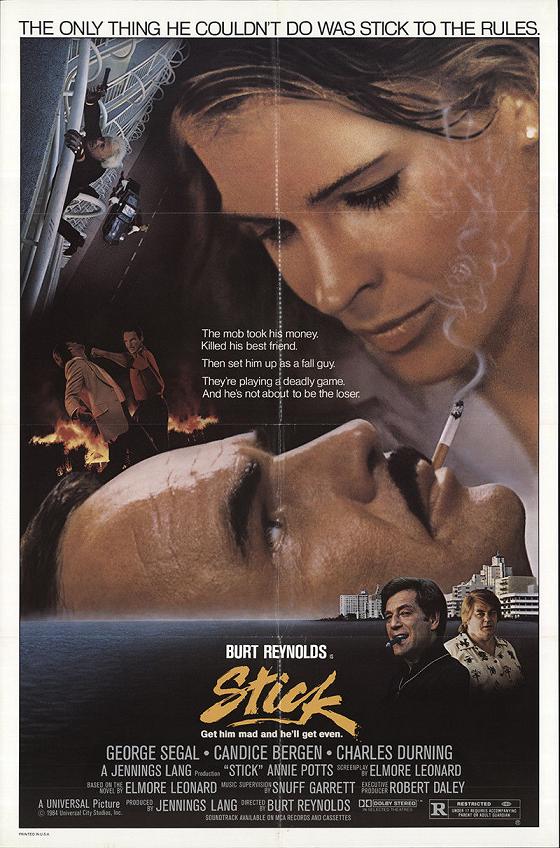
We do this thing, those of us who run small-time websites about movies, where we celebrate the “birthdays” of movies, commemorating release dates like historical events. In some cases, they are! In other cases, we’re just looking for something to write about. The release date of Tod Browning’s DRACULA is world history. The release date of JAWS is cinematic history. The release date of STICK might not be historic, to most.
But I am a Burt Reynolds enthusiast, advocate, even scholar. And STICK is an intriguing movie in that context. It’s a movie at the crossroads. Burt was on the far side of forty, nearly fifty, when he made it. It’s the next movie he made following CITY HEAT, the team-up with his pal Clint Eastwood and an eventual box-office disappointment, during the making of which Burt sustained a serious injury. As much as I believe public figures deserve their private lives, and as little as I relish applying a star’s biography to their movies, these details are out there already, and I do think knowing them may be able to cast a film like STICK, not widely remembered or admired, in a more generous light.
While filming a fight scene in CITY HEAT, Burt’s jaw was broken, resulting in him losing a significant amount of weight and kicking off tabloid rumors suggesting he had contracted AIDS – in 1984, there was no small amount of prejudice and bile behind such rumors. In 1984, I was in elementary school. On the playground, kids would sneer at each other and say, “You got AIDS!” – you’re weak, you’re sickly, you’re gay. That little pleasantry got thrown my way more than once. While Burt Reynolds was no homophobe, that kind of taunting couldn’t have landed easily upon the son of a cop, a football star, an international sex symbol whose countenance had been a shorthand for machismo across the past two decades.
In STICK, Burt plays an ex-con, a car thief many times over and a one-time armed robber, just done with seven years in prison. We never find out in the film what motivated the armed robbery, but it’s played as something serious Stick regrets having done. He rides the rails into town and immediately reconnects with a friend from prison, Rainy (José Pérez from SHORT EYES), who many other characters dismiss as “little” and a “spic” but who Stick clearly loves. The two of them head to a bar at 9:30am and when a loutish businessman from New York treats a girl-ish bartender without chivalry, Stick lights his ass up (literally) and slams his face into the bar. Rainy is set to make a cash drop for a low-life criminal named Chucky (Charles Durning), so Stick joins him. Chucky sends along a spooky albino henchman named Moke (Dar Robinson), with whom Stick instantly strikes up a mutual resentment. (Moke is the one who uses the aforementioned ethnic slur.) It’s a set-up, and Rainy is killed, leading Stick to fight his way out and to consider whether or not he can resist the temptation to avenge his murdered friend.

I’m recapping plot (this is only the first ten to fifteen minutes, by the way) as a means of illustrating how this is a quintessential Burt Reynolds character. The story is even set in Florida, where Burt spent much of his life. Stick is a character Burt would know how to play. He’s both a lover and a fighter. He’s tough but sentimental, angry but justified. Hardened killers stand down underneath the weight of his glare, but small-timers need not worry. When Rainy first sees Stick, he runs to him and leaps up in his arms, like a lover. Burt’s characters are romantic conquerors, secure in being desired by women, unafraid of heterosexual affection. His characters fight racists and sexists and bullies and pigs. As the movie progresses, Stick charms a smart, tough woman (played by Candice Bergen) and befriends a funny, black chauffeur (played by Richard Lawson). The evil Moke calls the latter character, Cornell, a “nigger.” That’s how you know Stick is going to have to kill him. It may not be complicated, and it probably isn’t progressive in any of the modern-day sense, but again, it’s quintessential Burt Reynolds.
So it’s evident what might appeal to Burt Reynolds in playing Ernest “Stick” Stickley. Solidly middle-aged, the heat of his star beginning to fade, facing public attacks on his masculinity, Burt may have wanted to prove he was still the same guy. He even directed the movie, possibly figuring nobody knew how to convey his persona better. That’s conjecture, but please note the extended montage in which Stick goes for a jog and does elevated push-ups while sporting short shorts, high socks, and a wet-suit vest of a top resembling the one Burt filled out so admirably in DELIVERANCE. Burt-as-Stick enters the movie wearing a thick beard, just for bonus virility. When he shaves the beard – but keeps the mustache – it’s onscreen, and a relatively big moment in the movie. This sort of business is only tangential to the plot. However, this is essential in the presentation of a movie star.

Of course if you ask me, Burt looks great in the movie, but he’s not the same guy he was in DELIVERANCE. He’s slimmer, less broad-shouldered, and his voice is a couple octaves lower – we’re well on our way now to the suave baritone of Jack Horner in BOOGIE NIGHTS. While there’s plenty of running throughout STICK, overall it feels slower than previous Burt Reynolds action movies. Burt moves a little more deliberately. The pacing of some scenes feels languid, and in truth he’s not as lithe as physical presence as he was in NAVAJO JOE, or in DELIVERANCE, or even in CITY HEAT. That’s not a terrible thing. Aging comes for us all. It’s how we choose to accept it that’s revealing.
STICK is an example of what I call Burt’s “Blue Period” – other examples include SHARKY’S MACHINE and HEAT. On the other side of massive popular success, on the other side of forty, Burt made films that were less raucous, more world-weary, still interjected with self-effacing humor, but with a growing sense of loss and mortality. Dave Kehr hits directly upon it in his review of STICK, which he called “a film haunted by an unstated, largely undramatized sense of melancholy, very personal but almost completely inarticulate.” My reading of STICK is probably a lot more generous, but I absolutely agree about the melancholy.
Look closely at the treatment of female characters in STICK. It’s telling. Stick has a now-fifteen-year-old daughter, Katie, who he works to reconnect with throughout the film. Played by Tricia Leigh Fisher (Carrie’s half-sister), she’s likable and believable, not exactly common for teen characters of the era, and the scenes between Katie and Stick are unusually tender. It’s fair to argue that the gender roles are somewhat remedial – Stick comes to the aid of the youthful bartender because she “reminds [him] of someone.” But I think Burt as director is sincere in his depiction. Likewise, Candice Bergen’s character is almost entirely unnecessary to the plot – she plays a financial adviser to the film-business-adjacent millionaire (George Segal) with a fascination with the crime world, whom Stick gets himself hired by in order to get closer to Chucky, Moke, and the big boss, Nestor (Cástulo Guerra). Because she’s played by Candice Bergen, she’s a character who we the audience like and buy into as intelligent and appealing, although when you think about it, she’s an accomplice to some shady characters. Burt as an actor is more engaged in lively in his scenes with Candice Bergen than he is elsewhere in the movie, where he’s sometimes going through the tough-guy motions. You can tell he enjoys doing the romantic sparring between his character and hers, and certainly Burt as a director presents her in the most flattering light. Again, the romantic subplot is so forced that it literally resolves over the end credits, wordlessly, under the movie’s love theme – “I Don’t Think I’m Ready for You,” based on a line of dialogue between the characters, sung by Anne Murray, and cowritten by Burt himself!!! – but it strikes me as genuinely-intended, if “largely undramatized.”

Of course, another reason STICK is viewed as a disappointment by critic-types is its imprimatur – it’s based on a novel by the master of crime fiction, Elmore Leonard. Leonard wrote the screenplay and was widely quoted as hating the movie that resulted, so much so that Burt publicly agreed with him. The script was rewritten by Joseph C. Stinson, who previously wrote SUDDEN IMPACT for Clint, not to mention CITY HEAT. (The movie was produced by Robert Daley, Clint’s longtime producing partner, and by Jennings Lang – PLAY MISTY FOR ME, HIGH PLAINS DRIFTER, CHARLIE VARRICK – so it’s very possible Burt was hoping for an Eastwood-esque prestige hit.) Elmore Leonard had a long career and his books were adapted to film many times, but sometimes you get a JACKIE BROWN and sometimes you’re lucky to get a 52 PICK-UP – it wasn’t guaranteed that a director would “get” his plotting, his dialogue, his tone, his vibe. Between picking an Elmore Leonard novel to adapt for STICK and a William Goldman novel for HEAT, it’s clear Burt had taste in material, but he didn’t have the lightness of touch as a director that he had in some of his finer moments as a performer. And by all accounts, the studio interfered in the making of the film, so we’ll never be able to judge Burt’s adaptation fairly. I do believe there is a world where Burt could have directed a great Leonard adaptation, but I have to admit that it wasn’t our world.

That said, there’s a lot to enjoy about STICK. It might come packaged with stuff that isn’t enjoyable, but it’s there, usually in the performances. As an actor first, Burt the director always did solid work with fellow actors. One strange exception is Charles Durning, one of Burt’s favorite actors, who might have made a great villain, but who shows up here with an orange wig and glued-on eyebrows, looking like a cross between that ginger “Mahna Mahna” Muppet and the disgraced movie blogger Harry Knowles. It’s definitely a choice. Honestly, Durning was far scarier as Doc Hopper. Also disappointing is Cástulo Guerra as the villain Nestor, whose performance is far too stagey and doesn’t match anyone else’s frequency in the film, although I did enjoy when he says to Chucky, “You owe me a life,” which took me a while to place. (It’s a line later to be used in Keanu Reeves’ directorial debut, MAN OF TAI CHI. Is Keanu a fellow Burt devotee?) The great Alex Rocco appears in one scene as a sleazy producer whose claim to fame is a film called THE COWBOY AND THE ALIEN. (I would love to see a survey of fictional titles of bad movies that went on to be produced by Hollywood for real.) The most memorable bad guy in the movie is Moke, played by the great stuntman Dar Robinson. It’s a shame he didn’t act more often. I most enjoyed Richard Lawson (Beyoncé’s stepdad! Wonder if Beyoncé has seen this movie?) as Stick’s buddy Cornell – he’s having the most fun of anybody in the whole thing, and Burt obviously relishes his company in their scenes together.
A movie doesn’t have to be great to be interesting. Sometimes it can serve as a magnifier, to inspect a small part of a much wider picture. STICK is a let-down as a capture of the voice of a great novelist. It’s a rickety picture visually, although Burt and cinematographer Nick McLean (STROKER ACE, CITY HEAT, CANNONBALL RUN II, THE GOONIES, SPACEBALLS, MAC & ME) do get off some striking shots of the Florida landscapes where it’s set, and some lovely close-ups of Burt and Candice Bergen. The score by Joseph Conlan and Barry De Vorzon (THE WARRIORS, NIGHT OF THE CREEPS, THE EXORCIST III) is exceptionally fun in a 1980s Harold Faltermeyer kind of way. These are elements I value, even if they don’t add up to a fully satisfying whole. Most people, when they think of Burt Reynolds, picture his work in the 1970s and the early 1980s and BOOGIE NIGHTS and leave it there. That may be understandable, and to hear Burt tell it half the time, a person wouldn’t be missing much if they checked the nooks and crannies of his career for movies like STICK. However, there are indelible little moments even in a B-side like STICK, even indulging in clichés as they may – a bearded ex-con riding a traincar, restless to start a new life after prison; a cleaned-up ex-con putting a hand to the cheek of a daughter he hadn’t seen since she was small; a tough guy wondering if he can change his ways enough to commit to the new woman in his life – that would all be a shame to miss, particularly when made and played by a performer as unique as Burt Reynolds.

- [THE BIG QUESTION] WHAT’S YOUR FAVORITE FEMALE ENSEMBLE IN MOVIES? - July 22, 2016
- [IN THEATERS NOW] THE BOY (2016) - January 24, 2016
- Cult Movie Mania Releases Lucio Fulci Limited Edition VHS Sets - January 5, 2016
Tags: Adaptations, Alex Rocco, America, Anne Murray, Barry De Vorzon, Books, Burt Reynolds, Candice Bergen, Charles Durning, Crime, Dar Robinson, Elmore Leonard, Florida, George Segal, Jennings Lang, Joseph Conlan, Joseph Stinson, Nick McLean, Richard Lawson, Robert Daley, Snuff Garrett, The 1980s, Tim Rossovich, Tricia Leigh Fisher






No Comments